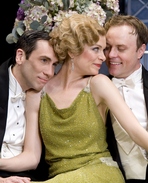SITE GUIDE
SEARCH
REVIEWS
REVIEW ARCHIVES
ADVERTISING AT CURTAINUP
FEATURES
NEWS
Etcetera and
Short Term Listings
LISTINGS
Broadway
Off-Broadway
NYC Restaurants
BOOKS and CDs
OTHER PLACES
Berkshires
London
California
New Jersey
Philadelphia
Elsewhere
QUOTES
TKTS
PLAYWRIGHTS' ALBUMS
LETTERS TO EDITOR
FILM
LINKS
MISCELLANEOUS
Free Updates
Masthead
A CurtainUp Review
Design for Living
|
The actual facts are so simple. I love you. You love me. You love Otto. I love Otto. Otto loves you. Otto loves me. There now! Start to unravel from there.Leo to Gilda
|

Robert Sella as Leo, Gretchen Egolf as Gilda and Tom Story as Otto in Noël Coward’s Design for Living.
( Photo by Scott Suchman) |
Coward's Design. . . is a never-ending circle: Leo, a playwright, Otto, a painter, and Gilda, their muse, are friends who couple, uncouple, and re-couple, make that triple. They are, in the playwright's words a "three-sided erotic hodge podge." These three free spirits are emotionally inseparable even when one side of the love triangle is absent.
The character of Leo (Robert Sella) the playwright is autobiographical. Coward, who came from a humble middle class background, became the toast of the town. Otto (Tom Story), the painter, and Gilda (Gretchen Egolf), an interior designer, are based on a real-life couple, actors Alfred Lunt and Lynn Fontanne. Director Michael Kahn has made sure these characters interpret their inner lives lucidly and without camp so that audiences have no trouble believing in the twists in alliances and plot.
I must admit that American productions of Noel Coward's plays have, in the past, left me cold, if not angry at the egregiously bad faux-Brit characterization and accents. Not so here. Robert Sella, Tom Story and Gretchen Egolf, deliver insouciance and style along with clipped speech in perfect balance. Sella's gift for timing and literate comedy is a revelation to those of us in Washington who have seen him do the classics only. Tom Story, especially when eating cold rice pudding, is like an over-grown child whose penchant for fun is never-ending. When drunk, in the second act, the two are well-paired and very funny. Sylph-like Gretchen Egolf is stylish but no bubblehead. She moves nimbly, while dispening wit and cunning. Also notable is Catherine Flye, an ex-pat Brit, whose take on the not-particularly useful maid is spot on.
In the 1930s, when the play was written and first produced, Leo and Otto's bisexuality offended the government's official censor and men, especially among the upper crust, did not know what to make of a woman like Gilda— a woman who enjoyed sex but not marriage, never wanted babies, and whose take on success and celebrity fluctuated between desire and repulsion.
Design For Living is as much as anything about the advantages of success and celebrity and the innate phoniness it brings to people's lives. A particularly revealing and amusing vignette comes in the second act — the best part of the evening. It's between Leo, who is basking in the reviews of his latest play and a clueless reporter who favors sports rather than culture. This gives Coward, through his mouthpiece Leo, a chance to spout off on the nature of theatre reviews and newspapers in general. Nostalgia, anyone? That act ends with Leo sitting on a couch, striking Noel Coward's most famous pose: head held high with a cigarette in a cigarette holder, of course, in his right hand, poised like a dart.
The style of the principals' playing is consistent. Their rise from living in genteel poverty in Paris, to professional and social ascent in London, and on to the pinnacle of fame and fortune — a high-floor penthouse in New York — moves smoothly. The ascent is helped greatly by James Noone's set designs. His artist's garret in Paris, so redolent of La Bohème, has hints of what is to come , such as the portrait of Gilda. The wood-paneled London drawing room, with its "thing" of a drinks cabinet, purple couch, and tea trolley on which meals are served is right out of London's famed Art Deco hotel, Claridge's (prior to renovation) and the ultimate in '30's sophistication the New York penthouse, with such Deco icons as a painting by Tamara de Lempicka. Looks aren't everything of course but costume designer Robert Perdziola has made the characters sigh-inducing elegant. Success becomes them.
What's remarkable about this production is its emphasis on the characters' inner lives, what they think makes life worth living. They evaluate themselves and each other with razor-sharp insights and wit. As they do so, you feel as though you have been, in words taken from Coward's famous song, ". . .to a Marvellous Party.""
Reviewed May 18, 2009. ‹br›‹br›
|
Design for Living By Noel Coward Director: Michael Kahn Cast: Gretchen Egolf (Gilda); Tom Story (Otto Sylvus); Robert Sella (Leo Mercuré); Kevin Hogan (Ernest Friedman); Catherine Flye (Miss Hodge); Todd Scofield (Mr. Birbeck); Sherri L. Edelen (Grace Torrence); Richard Thieriot (Henry Carver); Rebecca Kaasa (Helen Carver); Nathan Bennett (Matthew/Photographer). Set Designer, James Noone Costume Designer: Robert Perdziola Lighting Designer: Mark McCullough Sound Designer: Martin Desjardins Voice, Text and Dialect Coach: Gary Logan Fight Director: Brad Waller Running time: 3 hours, two intermissions Shakespeare Theatre Company at the Lansburgh Theatre 450 7th Street, NW, Washington, DC 202-547-1122; 877.487.8849 web site: Shakespearetheatre.org From 5/12/09; opening 5/18/09; closing 6/28/09 Reviewed by Susan Davidson on May 17, 2009 |
|
REVIEW FEEDBACK Highlight one of the responses below and click "copy" or"CTRL+C"
Paste the highlighted text into the subject line (CTRL+ V): Feel free to add detailed comments in the body of the email. . .also the names and emails of any friends to whom you'd like us to forward a copy of this review. You can also contact us at Curtainup at Facebook or Curtainup at Twitter |
Try onlineseats.com for great seats to
Wicked
Jersey Boys
The Little Mermaid
Lion King
Shrek The Musical

South Pacific

In the Heights

Playbill 2007-08 Yearbook

Leonard Maltin's 2008 Movie Guide


Wicked
Jersey Boys
The Little Mermaid
Lion King
Shrek The Musical

South Pacific

In the Heights

Playbill 2007-08 Yearbook

Leonard Maltin's 2008 Movie Guide


